A State-Based Programming Model for Wireless Sensor Networks
A State-Based Programming Model for Wireless Sensor Networks
A State-Based Programming Model for Wireless Sensor Networks
Create successful ePaper yourself
Turn your PDF publications into a flip-book with our unique Google optimized e-Paper software.
110 Chapter 6. Implementation<br />
Program 6.5: Example of an OSM program containing several state variables<br />
side-by-side with the its variable mapping in the host language C.<br />
Every state mapps into a corresponding union, containing both<br />
the variables of that state plus a representation of the state’s substates.<br />
Sequential and parallel compositions of substates are represented<br />
as a union and a struct of substate representations, respectively.<br />
1 state PROG_5 {<br />
2<br />
3 state C {<br />
4 var int c;<br />
5<br />
6 state A {<br />
7 var int a1, a2;<br />
8 e / outA(c) -> B;<br />
9 } // end state A<br />
10 state B {<br />
11 var int b1, b2;<br />
12 f / -> A;<br />
13 } // end state B<br />
14<br />
15 } // end state C<br />
16 ||<br />
17 state D {<br />
18 var int d;<br />
19 }<br />
20<br />
21 } // end state PROG_5<br />
1 struct statePROG_5 {<br />
2 struct par_C_D {<br />
3 struct stateC {<br />
4 int c;<br />
5 union seq_A_B {<br />
6 struct stateA {<br />
7 int a1, a2;<br />
8<br />
9 } _stateA;<br />
10 struct stateB {<br />
11 int b1, b2;<br />
12<br />
13 } _stateB;<br />
14 } _seq_A_B;<br />
15 } _stateC;<br />
16<br />
17 struct stateD {<br />
18 int d;<br />
19 } _stateD;<br />
20 } _par_C_D;<br />
21 } _statePROG_5;<br />
is only true <strong>for</strong> the variable mapping. Control structures are first mapped to an<br />
intermediate representation in the imperative language Esterel [19, 18, 26]. From<br />
this representation, C code is generated by an Esterel compiler.<br />
The Esterel Synchronous Language<br />
Esterel is a synchronous language (see, <strong>for</strong> example, [17, 50, 95]) <strong>for</strong> the specification<br />
of reactive systems. Synchronous languages are reactive in that they react<br />
to input stimuli (i.e., events) in order to compute output events, typically also<br />
changing the internal program state. Synchronous languages are typically used<br />
to implement control systems, such as, industry process control, airplane and<br />
automobile control, embedded systems, bus interfaces, etc. They are built on<br />
the hypothesis that operations take no (real) time, that is, operations are atomic<br />
and the output of an operation is synchronous with its input (hence the name<br />
synchronous language). Synchronous languages have a discrete model of time<br />
where time progresses only on the occurrence of events.<br />
The Esterel language allows to specify concurrent processes, where individ-
















